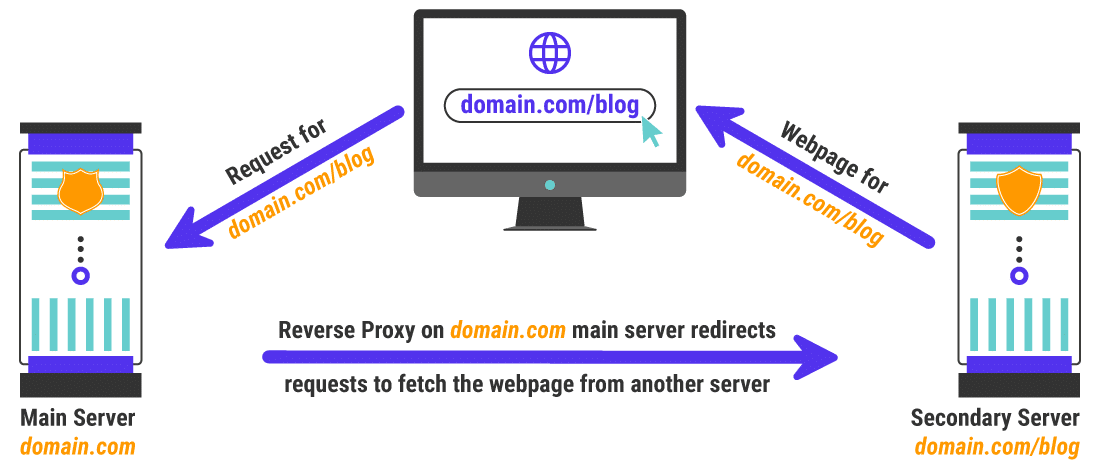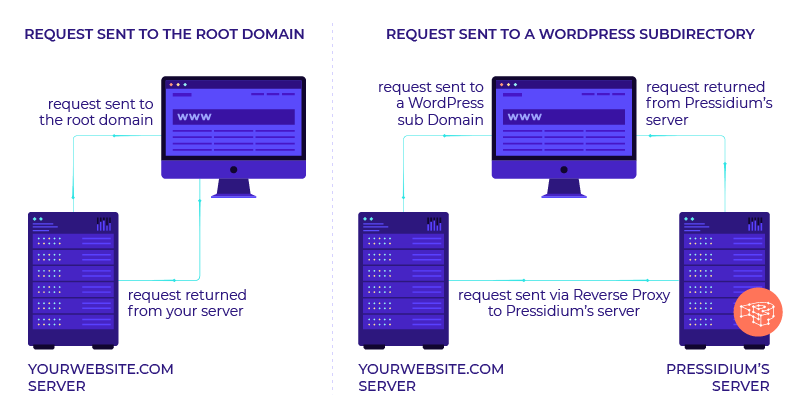Moz Q&A is closed.
After more than 13 years, and tens of thousands of questions, Moz Q&A closed on 12th December 2024. Whilst we’re not completely removing the content - many posts will still be possible to view - we have locked both new posts and new replies. More details here.
WordPress Sub-directory for SEO
-
Hi There,
I'm working on a WordPress site that includes a premium content blog with approx 900 posts.
As part of the project, those 900 posts and other membership functionality will be moved from the main site to another site built specifically for content/membership.
Ideally, we want the existing posts to remain on the root domain to avoid a loss in link juice/domain authority.
We initially began setting up a WordPress Multisite using the sub-directory option. This allows for the main site to be at www.website.com and the secondary site to be at www.website.com/secondary.
Unfortunately, the themes and plugins we need for the platform do not play nicely with WordPress Multisite, so we started seeking a new solution, and, discovered that a second instance of WordPress can be installed in a subdirectory on the server. This would give us the same subdirectory structure while bypassing WordPress Multisite and instead, having two separate single-site installs.
Do you foresee any issues with this WordPress subdirectory install? Does Google care/know these are two separate WordPress installs and do we risk losing any link juice/domain authority?
-
@himalayaninstitute said in WordPress Sub-directory for SEO:
WordPress can be installed in a subdirectory
I have done this a lot and I mean a lot what you want to do is set up a reverse proxy on your subdomain and this will allow you to not only bypass having to use multisite for subfolder but if you want to power it separately you can you do not have to it all. You should probably use your same server and power through Fastly our CloudFlare


once you set this up it is super easy to keep it running in your entire site will be much faster as a result as well
my response to someone else that needed a subfolder
https://moz.com/community/q/topic/69528/using-a-reverse-proxy-and-301-redirect-to-appear-sub-domain-as-sub-directory-what-are-the-seo-risksplease also look at it explained by these hosting companies is unbelievable easy to implement compared to how it looks and you can do so with Fastly or cloudflare in a matter of minutes
-
https://servebolt.com/help/article/cloudflare-workers-reverse-proxy/
-
https://support.pagely.com/hc/en-us/articles/213148558-Reverse-Proxy-Setup
-
https://wpengine.com/support/using-a-reverse-proxy-with-wp-engine/
-
https://thoughtbot.com/blog/host-your-blog-under-blog-on-your-www-domain
-
https://crate.io/blog/fastly_traffic_spike
*https://support.fastly.com/hc/en-us/community/posts/4407427792397-Set-a-request-condition-to-redirect-URL -
https://coda.io/@matt-varughese/guide-how-to-reverse-proxy-with-cloudflare-workers
-
https://www.cloudflare.com/learning/cdn/glossary/reverse-proxy/
-
https://gist.github.com/LimeCuda/18b88f7ad9cdf1dccb01b4a6bbe398a6
I hope this was of help
tom
-
-
@nmiletic The content section of the site requires a unique UI Design and other robust functionality, so having a separate theme/plugins in its own directory is going to be the way we go here. Thanks for your assistance!
-
@himalayaninstitute Have you thought about adding a page and making all of this new content a subpage? Or changing your permalink structure to include a category in the URL? You can then add all of these posts under that category and have the URL show up as www.example.com/category/page-or-post-name
-
The website at the subdirectory will be an online learning platform with a blog, online courses, memberships, gated content, etc. The content currently lives on the main site, so, it's great that we can move it into the subdirectory without taking a hit from Google.
Since these are fundamentally two separate websites, we're not concerned about needing to manage them independently.
Thanks again for your input and advice, we greatly appreciate it!
-
@amitydigital said in WordPress Sub-directory for SEO:
Google will view it as one site so you shouldn't have any issues from that perspective. The Google bot is just looking at pages and won't know/care that the underlying CMS that is running some pages is a different install than other pages. The downside is you now have two websites to maintain, two themes, two sets of files, etc... That may result in a bit of a headache in the future.
As @amitydigital put it, the issue with your approach would be repetitive tasks. You will not loose any DA nor PA (being that you implement a correct 301 redirection). What is going to be on the subdirectory?
-
Google will view it as one site so you shouldn't have any issues from that perspective. The Google bot is just looking at pages and won't know/care that the underlying CMS that is running some pages is a different install than other pages. The downside is you now have two websites to maintain, two themes, two sets of files, etc... That may result in a bit of a headache in the future.
Got a burning SEO question?
Subscribe to Moz Pro to gain full access to Q&A, answer questions, and ask your own.
Browse Questions
Explore more categories
-
Moz Tools
Chat with the community about the Moz tools.
-
SEO Tactics
Discuss the SEO process with fellow marketers
-
Community
Discuss industry events, jobs, and news!
-
Digital Marketing
Chat about tactics outside of SEO
-
Research & Trends
Dive into research and trends in the search industry.
-
Support
Connect on product support and feature requests.
Related Questions
-
Unsolved Using Weglot on wordpress (errors)
Good day to you all, Does anyone have experience of the errors being pulled up by Moz about the utility of the weglot plugin on Wordpress? Moz is pulling up URLs such as: https://www.ibizacc.com/es/chapparal-2/?wg-choose-original=false These are classified under "redirect issues" and 99% of the pages are with the ?wg-choose parameter in the URL. Is this having an actual negative impact on my search or is it something more Moz related being highlighted. Any advice be appreciated and a resolution .. Im thinking I could exclude this parameter.
Moz Pro | | alwaysbeseen0 -
Should posts show in multiple categories?
Hi all, For context, I'm trying to Silo my content more efficiently. I've just moved all content into their own SILO'd categories and removed them from duplicate categories. As such, posts now sit only in 1 category. My question here is: Should my posts be showing in both the parent category and its sub category or just the sub-category? I've currently got this only showing in the sub-categories it's relevant to. For example:
On-Page Optimization | | xtrapsp
Post name: Shimano Fishing Rod Review
Parent Category: Fishing Rods
Sub Category: Shimano And the post only shows inside the Shimano Category0 -
Using a Reverse Proxy and 301 redirect to appear Sub Domain as Sub Directory - what are the SEO Risks?
We’re in process to move WordPress blog URLs from subdomains to sub-directory. We aren’t moving blog physically, but using reverse proxy and 301 redirection to do this. Blog subdomain URL is https://blog.example.com/ and destination sub-directory URL is https://www.example.com/blog/ Our main website is e-commerce marketplace which is YMYL site. This is on Windows server. Due to technical reasons, we can’t physically move our WordPress blog to the main website. Following is our Technical Setup Setup a reverse proxy at https://www.example.com/blog/ pointing to https://blog.example.com/ Use a 301 redirection from https://blog.example.com/ to https://www.example.com/blog/ with an exception if a traffic is coming from main WWW domain then it won’t redirect. Thus, we can eliminate infinite loop. Change all absolute URLs to relative URLs on blog Change the sitemap URL from https://blog.example.com/sitemap.xml to https://www.example.com/blog/sitemap.xml and update all URLs mentioned within the sitemap. SEO Risk Evaluation We have individual GA Tracking ID and individual Google Search Console Properties for main website and blog. We will not merge them. Keep them separate as they are. Keeping this in mind, I am evaluating SEO Risks factors Right now when we receive traffic from main website to blog (or vice versa) then it is considered as referral traffic and new cookies are set for Google Analytics. What’s going to happen when its on the same domain? Which type of settings change should I do in Blog’s Google Search Console? (A). Do I need to request “Change of Address” in the Blog’s search console property? (B). Should I re-submit the sitemap? Do I need to re-submit the blog sitemap from the https://www.example.com/ Google Search Console Property? Main website is e-commerce marketplace which is YMYL website, and blog is all about content. So does that impact SEO? Will this dilute SEO link juice or impact on the main website ranking because following are the key SEO Metrices. (A). Main website’s Avg Session Duration is about 10 minutes and bounce rate is around 30% (B). Blog’s Avg Session Duration is 33 seconds and bounce rate is over 92%
Intermediate & Advanced SEO | | joshibhargav_200 -
Does changing template for a wordpress site affect SEO
Hi I work for an Inventory Management Software company and we already have a WordPress site but I am currently working on re-designing of our WordPress site and in this process, we are looking for moving to a new template. I want to know what will be the impact on SEO performance while taking a shift to a new template.
Intermediate & Advanced SEO | | Cin7_Marketing0 -
Best Practices for Moving a Sub-Domain to a Sub-Folder
One of my clients is moving their subdomain to a subfolder on their main domain. (ie. blog.example.com to example.com/blog) I just wanted to get everyone's thoughts on some best practices for things we should be doing/looking for when making this move.? ie WMT, .htaccess, 301s etc? Thanks.
Intermediate & Advanced SEO | | DarinPirkey0 -
Domain Alias SEO
We have 5 domain alias of our existing sites
Intermediate & Advanced SEO | | unibiz
All 5 domain alias are domain alias of our main site. It means, all domain alias will have exactly same site and contents
Like Main domain: www.mywebsite.com
DomainAlias: www.myproduct.com, www.myproduct2.com, www.myproduc3.com
And if anybody will open our site www.myproduct.com, it will open same website which I have in primary site what can i do to rank all website without any penalty....i s there any way? This is domain alias of in hosting industry Thanks0